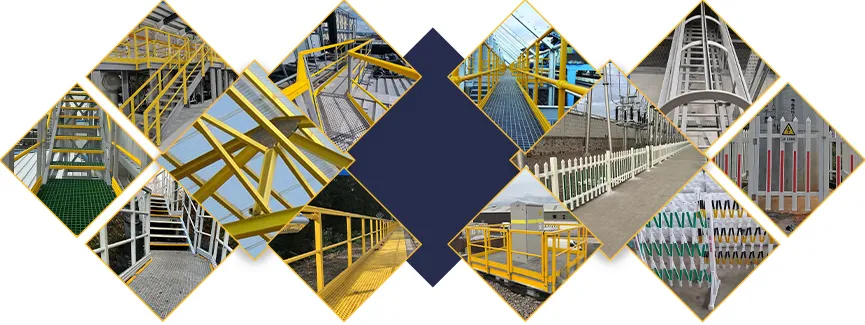loading...
- No. 9, Xingyuan South Street, Dongwaihuan Road, Zaoqiang County, Hengshui, Hebei, China
- admin@zjcomposites.com
- +86 15097380338
- Welcome to visit our website!
Exploring the Benefits of FRP Profiles in Modern Construction Applications
Exploring FRP Profiles A Sustainable Approach to Modern Construction
In recent years, the construction industry has witnessed significant advancements in materials and technology, paving the way for innovative solutions to age-old challenges. Among these, Fiber Reinforced Polymer (FRP) profiles have emerged as a game changer. These materials, known for their superior strength-to-weight ratio, corrosion resistance, and design versatility, are increasingly being recognized as a sustainable alternative to traditional construction materials like steel and concrete.
What are FRP Profiles?
Fiber Reinforced Polymers are composite materials made of a polymer matrix combined with fibers that can include glass, carbon, aramid, and more. FRP profiles can take various forms, including beams, columns, and slabs, and are produced through advanced manufacturing processes such as pultrusion or filament winding. These profiles are designed to enhance the mechanical properties of the base polymer, making them suitable for a wide range of applications in construction.
Advantages of FRP Profiles
1. Lightweight and Strong One of the primary advantages of FRP profiles is their lightweight nature, which is often a fraction of the weight of traditional materials. This characteristic not only makes them easier to transport and install but also reduces the load on structural systems, allowing for innovative architectural designs.
2. Corrosion Resistance Unlike steel, which is susceptible to rust and degradation when exposed to moisture and harsh chemicals, FRP profiles are inherently resistant to corrosion. This property makes them an ideal choice for structures in marine environments, chemical plants, and other industrial settings where exposure to aggressive agents is a concern.
3. Longevity The durability of FRP profiles ensures that structures can last longer with minimal maintenance. This quality not only reduces the need for repairs and replacements but also contributes to lower lifecycle costs, making FRP an economically attractive option in the long run.
frp profiles

4. Thermal and Electrical Insulation FRP profiles provide excellent thermal and electrical insulation, reducing energy costs in buildings. This feature can be particularly valuable in enhancing energy efficiency, thereby supporting sustainable construction practices.
Applications of FRP Profiles
FRP profiles are increasingly finding their way into various sectors due to their unique properties. In civil engineering, they are used for bridge construction, where their lightweight nature allows for longer spans and reduced support requirements. Similarly, in the building sector, they are utilized for structural components, facades, and reinforcement of existing structures.
In transportation, FRP profiles are frequently employed for vehicle chassis and parts, where strength and weight savings are critical for performance and fuel efficiency. Their corrosion resistance makes them highly desirable in the automotive and aerospace industries, where exposure to varying environmental conditions is common.
Environmental Impact
As the world grapples with climate change, the construction industry is under increasing pressure to adopt more sustainable practices. FRP profiles contribute positively to this transition by reducing material waste and energy consumption. Their longevity and low maintenance needs minimize the environmental impact over their lifecycle compared to traditional materials that often require more frequent replacements.
Conclusion
The evolution of construction materials has brought FRP profiles to the forefront as a sustainable and efficient choice for modern building projects. Their unique combination of strength, lightweight properties, and resistance to environmental degradation offers a compelling case for architects and engineers seeking innovative solutions. As the industry continues to embrace sustainability, FRP profiles are poised to play a crucial role in the future of construction. With ongoing advancements in material technology, their applications are expected to expand, further solidifying their place in the architectural landscape. As we look ahead, the adoption of FRP profiles reflects a commitment to innovation while promoting a more sustainable future.
-
GRP Structures: The Future of Lightweight, High-Performance EngineeringNewsJun.20,2025
-
FRP Water Tank: High-Performance Storage for Corrosive and Clean Water SystemsNewsJun.20,2025
-
FRP Square Tube: The New Industry Standard for Chemical and Structural ApplicationsNewsJun.20,2025
-
FRP Pultruded Profiles: The Ultimate Choice for Lightweight Structural StrengthNewsJun.20,2025
-
FRP Handrails: The Safer, Smarter, and Stronger Choice for Modern InfrastructureNewsJun.20,2025
-
FRP Grating: The Smart Solution for Durable, Lightweight Industrial FlooringNewsJun.20,2025
-
Why Choose a Galvanized Water Tank for Your Storage NeedsNewsMay.21,2025
